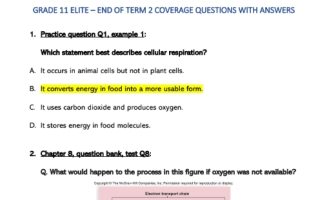أوراق عمل مراجعة هيكل امتحان الأحياء مع الحل الصف الحادي عشر Elite الفصل الثاني
Ans. During cellular respiration, oxygen plays a crucial role in the electron transport chain (ETC), which is the final stage of the process. In this stage, the electrons produced from the previous stages are transferred along a series of proteins in the inner mitochondrial membrane, ultimately leading to the production Of ATP, the energy currency Of the cell
If oxygen is not available during the ETC, the whole process Of cellular respiration would be disrupted. The electron carriers (such as NADH and FADH2) would accumulate, as they would not be able to transfer their electrons to the ETC, leading to a buildup of these molecules. This would cause a bottleneck in the electron transport chain, halting the production Of ATP
As a result, the cell would be unable to generate enough energy to Carry out its metabolic processes, leading to a decrease in cellular function and eventually cell dæth
Chapter 8. question banks content review QI 1
The first phase Of cellular respiration is
the citric acid cycle glycolysis
the electron transport system fermentation
the preparatory reaction
Practice quætion Q2. example 2
Which of the following statements is true regarding cellular ræpiration
Anaerobic respiration requires oxygen in order to generate ATP
The citric acid cycle produces NADPH, which releases energy to fuel chemiosmosis
Oxygen is formed as water combines with electrons at the end of the electron transport chain
Glucose is broken down into two pyruvate molecules during glycolysis
The complete breakdown Of glucose in cells occurs through a series Of four phases glycolysis, the preparatory reaction, the Krebs cycle (also known as the citric acid cycle), and oxidative phosphorylation
The first phase of glucose breakdown is glycolysis, which occurs in the Cytoplasm Of Cells. During glycolysis, glucose is converted into two molecules Of pyruvate, producing a net gain of 2 ATP and 2 NADH. No carbon dioxide (C02) is produced during glycolysis
The second phase Of glucose breakdown is the preparatory. reaction, which occurs in the mitochondria. During this phase, pyruvate is oxidized and converted to acetyl COA, which enters the Krebs cycle. The preparatory reaction releases CO. as a waste product, but no ATP or water is produced The third phase of glucose breakdown is the Krebs cycle, which also occurs in the mitochondria. During this phase, acetyl CoA enters a seriß of reactions that produce C02 a waste product, and 1 ATP, 3 NADH, I FADH2
for each cycle. No water is produced during the Krebs cycle
The final phase of glucose breakdown is oxidative phosphorylation, which also occurs in the mitochondria. During this phase, NADH and FADH2 are oxidized, releasing energy that is used to create a proton gradient across the mitochondrial membrane. This gradient is then used by ATP synthase to produce ATP from ADP and inorganic phosphate. Water is produced during oxidative phosphorylation as a byproduct of oxygen (O' reduction
Overall, the complete breakdown of glucose involves both oxidation and reduction reactions and produces energy in the form of ATP. Carbon dioxide and water are produced as waste products at various stages of the process
structure Md and mibdwndria Chloroplasts and mitochondria are two organelles found in eukaryotic cells, but they have different structures and functions
Chloroplasts are generally larger and have a more complex structure than mitochondria. They have a double membrane system, with an outer membrane and an inner membrane, which encloses a fluid- filled space called the stroma. Inside the stroma are thylakoid membranes, which are flattened sacs that contain chlorophyll and other pigments used in photosynthesis
Mitochondria also have a double membrane System, with an outer membrane and an inner membrane that encloses a fluid -filled space called the matrix. The inner membrane is highly folded into structures called cristae, which provide a large surface area for the enzymes involved in cellular respiration
Chloroplasts are responsible for carrying out photosynthesis, the process by which plants and algae convert sunlight into energy in the form Of ATP and organic molecules such as sugars. Chlorophyll and other pigments absorb light energy, which is used to power the conversion of carbon dioxide and water into glucose and oxygen
Mitochondria are responsible for cellular respiration, the process by which cells convert glucose and oxygen into energy in the form Of ATP. This process occurs in the matrix and on the cristae Of the inner membrane, where enzymes and electron transport chains carry out a series of chemical reactions that generate AT
Ans. Cancer cells are abnormal cells that divide uncontrollably and can invade nearby tissues and spread to other parts of the body. The major characteristics Of cancer cells that distinguish them from normal cells are Cancer cells divide and grow uncontrollably, leading to the formation of tumors
Lack of inhibiöon: Normal cells stop dividing when they come into contact with other cells, but cancer cells do not exhibit this inhibition and continue to grow despite contact with neighboring cells
Cancer cells have unstable genomes and are prone to mutations, which can lead to the activation of oncogenes (genes that promote cell growth and division) and the inactivation of tumor suppressor genß (genes that inhibit cell growth and division)
Cancer cells are resistant to apoptosis, a natural process of programmed cell death that eliminates damaged or abnormal cells Cancer cells can induce the formation Of new blood vßsels (angiogenesis) to supply the growing tumor with nutrients and oxygen
Cancer cells can invade nearby tissues and spread to distant parts of the body, forming secondary tumors in a process known as metastasis
Overall, cancer cells have multiple abnormalities that distinguish thern from. normal cells and contribute to their ability to grow uncontrollably and spread throughout the body
A. Cancer cells Often undergo angiogenesis
B. Cancer cells tend to be nonspecialized
C. Cancer cells undergo apoptosis
D. Cancer cells Often have abnormal nuclei
Ans. During meiosis, the process by which cells divide to form gametes (sex cells) chromosomes undergo a process called pairing or synapsis, where they align and form homologous pairs. This is a crucial step in meiosis because it allows for the exchange of genetic information between homologous chromosomes, which increases genetic diversity
A bivalent, also known as a tetrad, is formed when two homologous Chromosomes come together during meiosis and form a structure containing four chromatids. The chromatids are held together at points called which allow for the exchange of genetic material between the chromosomes. This exchange of genetic material is known as crossing over and results in the shuffing Of genetic information between homologous Chromosomes, further increasing genetic
diversity
The purpose Of bivalent formation during meiosis is to ensure that each gamete receives a complete set of chromosomes that are different from one another. The bivalent formation allows for the pairing of homologous chromosomes, which helps to ensure that the resulting gametes have the correct number of chromosomes and that the genetic information they carry is different from each other. This is important
for sexual reproduction, as it helps to increase genetic diversity within a population, which can increase the chances Of survival in changing environments
During meiosis l, the homologous pairs of chromosomes randomly align themselves along the equator of the cell. This means that each daughter cell can end up with a different combination of maternal and paternal chromosomes, leading to a diverse set of gametes with different combinations Of alleles. The number Of possible combinations is 2" where n is the number of homologous chromosome pairs in the organism. For example, humans have 23 pairs of chromosomes, so there are 223 (or over 8 million) possible combinations of chromosomes in a human
gamete
Overall, these two mechanisms of genetic variation, crossing over and independent assortment, help to ensure that each offspring produced by sexual reproduction is genetically unique, which contributes to the genetic diversity ofa population
The haploid (n) number of chromosomes for a human being is
Ans. During meiosis, cells undergo two rounds of cell division, resulting in the formation of four haploid cells from one diploid cell
I is the stage of meiosis I where homologous pairs of chromosomes align at the metaphase plate. During this stage, the chromosomes in each homologous pair come together, forming a tetrad. The chromosomal combination in each cell at metaphase I is haploid, but each chromosome consists of two sister chromatids
On the other hand, II is the Stage of meiosis II where individual chromosomes align at the metaphase plate. At this stage, the two sister chromatids of each chromosome separate and move towards opposite poles. The chromosomal combination in each cell at metaphase II is haploid, and each chromosome has only
one chromatid
Metaphase in Mitosis and Meiosis (Metaphase 1 and 2)
Therefore, the main difference between the chromosomal combinations of a cell at metaphase I and metaphase II of meiosis is the number of chromatids. At metaphase l, each chromosome has two sister chromatids, while at metaphase II, each chromosome has only one chromatid. Additionally, during metaphase l, homologous chromosomes align at the metaphase plate, while during metaphase II, individual chromosomes align
Ans. Germinating seeds are used to determine that cellular respiration is taking place because during germination, the seed is actively metabolizing and using energy. As the germinating seeds consume oxygen and produce carbon dioxide, it provides a way to measure the rate of cellular respiration
Ans. Create two groups of germinating seeds such that. one group at room temperature and one group at a slightly lower temperature. Then measure the rate of cellular respiration for both groups over time to compare and see how the different temperatures affect the rate Of respiration. The group at the lower temperature would be the experimental group, and the group at room ternperature would be the control group
: A blank control is a control group that contains all the components of the experimental group except for the germinating seeds. This control is used to account for any changes in gas volume that may occur due to factors other than cellular respiration, such as leaks or changes in temperature
: Temperature can affect the rate of cellular respiration, so it is important to keep the temperature constant throughout the experiment. A temperature control can be used to ensure that the temperature remains constant throughout the experiment
Volune Control: It is important to ensure that the volume of the experimental group and control group are the same. so that any changes in gas volume can be accurately attributed to cellular respiration. A volume control can be used to ensure that the volumes Of the experimental and control groups are the same
b. The termentation reaction regenerates NAO", which is required tor the first step in the energy-harvesting phase of glycolysis
C. Fermentation can provide a rapid burst of ATP
D. All of the choices are advantages
E. None of the choices is an advantage
Ans. The breakdown of glucose can occur through different metabolic processes, including glycolysis, the Krebs cycle, and the electron transport chain (ETC). The majority of ATP is produced during the final stages of glucose breakdown, which occur in the Krebs cycle and the ETC.During the Krebs cycle, acetyl -CoA produced from pyruvate enters a series of chemical reactions that produce several high-energy molecules, including ATP, NADH. and FADH2. These energy- rich molecules then enter the ETC, where they undergo a series of redox reactions that ultimately produce ATP
The ETC is responsible for the majority of ATP production during glucose breakdown, as it uses the energy from NADH and FADH2 to pump hydrogen ions across the inner mitochondrial membrane, creating an electrochemical gradient. This gradient is then used to power ATP synthase, which generates ATP from ADP and phosphate
Overall, while glycolysis plays a key role in glucose breakdown, the majority of ATP is produced during the electron transport chain, which occur in the mitochondria These processes are much more efficient at generating ATP and provide cells with a more sustained source of energy




